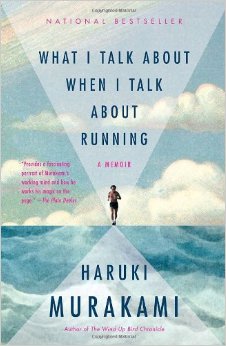 Japanese novelist Haruki Murakami started running because he hoped to become healthy and write novels long term.Murakami managed a jazz club in Tokyo and smoked sixty cigarettes a day. “If I wanted to have a long life as a novelist, I needed to find a way to keep fit and maintain a healthy weight,” he writes in his book, What I Talk About When I Talk about Running.
Japanese novelist Haruki Murakami started running because he hoped to become healthy and write novels long term.Murakami managed a jazz club in Tokyo and smoked sixty cigarettes a day. “If I wanted to have a long life as a novelist, I needed to find a way to keep fit and maintain a healthy weight,” he writes in his book, What I Talk About When I Talk about Running.
In the book, running isn’t just a health boost, it’s an essential metaphor and psychological foundation for running. The acts of running and writing spool out in parallel. In the end, they’re so closely aligned they may be indistinguishable.
First, the parallels:
Goals:
Most ordinary runners are motivated by an individual goal, more than anything, namely, a time they want to beat. … Even if he doesn’t break the time he’d hoped for, as long as he has the sense of satisfaction at having done his very best – and, possibly, having made some significant discovery about himself in the process – then that in itself is an an accomplishment, a positive feeling he can carry over to the next race.The same can be said about my profession. In the novelist’s profession, as far as I’m concerned, there’s no such thing as winning or losing. Maybe numbers of copies sold, awards won, and critics praise serve as outward standards for accomplishment in literature, the none of the really matter. What’s crucial is whether your writing attains the standards you’ve set for yourself.
Style:
When you see runners in town it’s easy to distinguish beginners from veterans. The ones panting are beginners; the ones with quiet, measured breathing are the veterans. Their hearts, lost in thought, slowly tick away time. When we pass each other on the road, we listen to the rhythm of each other’s breathing, and sense the way the other person is ticking away the moments. Much like two writers perceive each other’s diction and style.
Rhythm:
Running is a great activity to do while memorizing a speech. As, almost unconsciously, I move my legs, I line the words up in order in my mind. I measure the rhythm of the sentences, the way they’ll sound.
Starting fresh:
For the first time in a long while, I feel content running every day in preparation for the next marathon. I’ve opened a new notebook, unscrewed the cap on a new bottle of ink, and am writing something new.
So those are some of the alignments between Murakami’s running and writing.
The co-dependency is more basic, though, assuming the book’s English language translator captured the spirit and cadence of the Japanese original. Murakami’s style as a writer – accretive, looping, lacking in crescendos or dramatic leaps, self-effacing, each sentence building on the last, each sentence carrying us a few steps further on the path of tale – is very much the methodical rhythm of his running.
Step by step, lap by lap, mile by mile, marathon by marathon. Here’s a passage I chose pretty much at random that lays out Murakami’s steady rhythm:
I also bought some new Mizuno running shoes. At City Sports in Cambridge I tried on all kinds of models, but ended up buying the same Mizunos I’ve been practicing in. They’re light, and the cushioning of the sole is a little hard. As always, they take a while to get used to. I like the fact that this brand of shoes doesn’t have any extra bells and whistles. This is just my personal preference, nothing more. Each person has his own likes. … I’m going to break these new shoes in, now that I have only a month left before the race.
Step, step, step. Step, step, step. Step, step, step. The rhythm of a runner even paces the book’s title, What I Talk About When I Talk About Running. Step, step, step. Step, step, step.

